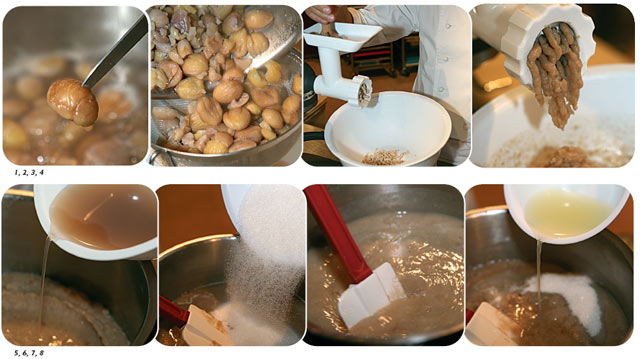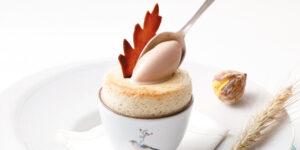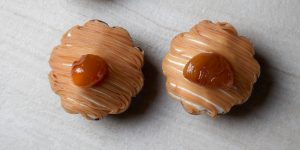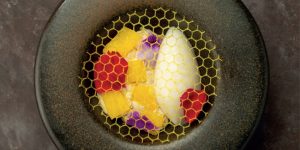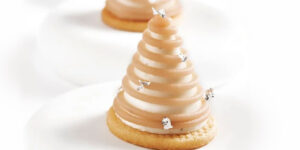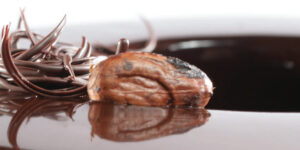Chestnut jam preserves Ramon Morató
CHESTNUT TIME. Artisanal preserves, by Ramon Morató
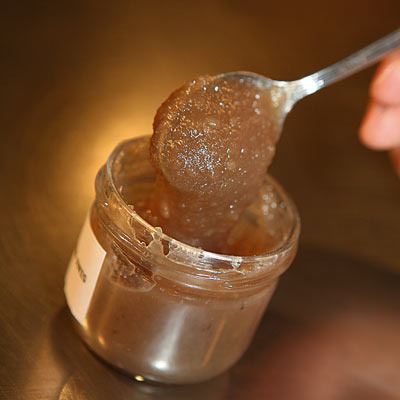
It is time for chestnuts. A good way of conserving this fruit so that it may be consumed year round is by transforming it into preserves. Ramon Morató, well-known master chocolatier, has undergone a profound study on the creation of artisanal preserves which is presented here and now. And as an example, a very appropriate jam for this season is chestnut and anise preserves.
Jam/preserve is a solution of fruit and sugar concentrated due to the evaporation of the water contained in the fruit until a thick gel is obtained.
The final texture of jam should be that of a dense gel but still easy to handle with a spatula.
Regarding the way this characteristic texture is obtained, two different aspects stand out:
- a bigger o smaller concentration of the solution while prepared.
- the relation between the raw materials.
By concentrating the solution to a larger or smaller extent, a thicker or less thick jam will be obtained. The concentration is usually verified in degrees brix, and we should normally work at levels between 60 and 65ºBrix.
Regarding the relation among the raw materials, the final texture of the fruit jam should be mainly determined by the balance among the three ingredients below:
- The sugars
- The pectin
- The acidity
THE FRUIT
Besides providing the natural pectin and the acidity from the fruit itself, fruit provides enough water for the sugars to dissolve. Remember that most fruits have approximately 90% water content.
SUGARS
They provide a sweet flavor and are responsible for the jam preservation. This is the case of sucrose, which acts as a bulking agent as it is the main one. Glucose syrups are also used to provide a low sweetening power as well as to avoid crystallization.
ACID
Acid is responsible for reducing the pH value down to a level between 3 and 4, consequently forcing the pectin to gel.
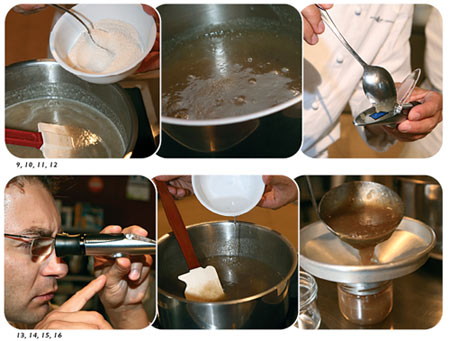 There are several and varied acid products at our disposal in order to reduce the pH level. For our own purpose, natural lemon juice has been used.
There are several and varied acid products at our disposal in order to reduce the pH level. For our own purpose, natural lemon juice has been used.
PECTIN
The pectin contained in fruits does not often appear in enough quantity as to provide the jams with the required texture. Therefore, we usually add some pectin to the mixture.
There are several types of pectins, each having different technological characteristics. For our own purpose, Medium Rapid Set pectin is used, as this pectin gels in an acid environment at a level of 3.3 approximately.
PRESERVATION
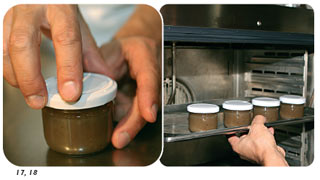 Jams have high sugar content. As a result, their preservation does not pose a problem as far as microbiology is concerned, except for fungi, which can reproduce even in low Aw (activity of water) and pH levels on the surface of the jam.
Jams have high sugar content. As a result, their preservation does not pose a problem as far as microbiology is concerned, except for fungi, which can reproduce even in low Aw (activity of water) and pH levels on the surface of the jam.
After preparing them and putting them in glass jars, jams undergo a heat treatment which will ensure a correct pasteurization.
When unsealed, it is necessary to keep them in refrigerator.
chestnut and anise jam
- 3,000 g boiled chestnut purée (2,500 g gross)
- 1,500 g sugar
- 750 g water resulting from boiling the chestnut
- 600 g glucose syrup DE 44
- 300 g sugar
- 16 g Medium Rapid Set pectin
- 210 g lemon juice
- 230 g Dry Anís del Mono
- Boil the 2,500 g chestnuts with 2,500 g water and 3 g salt for about 30 minutes.
- Strain the chestnuts and keep the remaining water aside.
- Process the boiled chestnuts with the ‘Robot Coupé’ and weigh until obtaining the 3,000 g needed.
- Add the water resulting from the boiling, the lemon juice, the sugars at intervals and the mixture of sugar and pectin.
- Place over a low heat until it comes to a boil, and then increase the heat.
- Boil to 66º Brix approximately. Let cool down for a few minutes and add in the anisette.
- Immediately put into glass jars.
- Seal and place into a steam oven for approximately 45 minutes.
- Rapidly cool down, label and store.
 Frozen, raw, peeled chestnuts have been used for this recipe. Their initial weight is approximately 2,500 g, but after boiling in water, the chestnuts hydrate and gain some weight. As a result, their final weight –after the boiling process- should be approximately 3,000 g.
Frozen, raw, peeled chestnuts have been used for this recipe. Their initial weight is approximately 2,500 g, but after boiling in water, the chestnuts hydrate and gain some weight. As a result, their final weight –after the boiling process- should be approximately 3,000 g.
In order to control the regularity in the preparation of jams a refractometer is used, which will give us a reading in degrees brix. This reading states the total content of soluble sugars in the mixture: 60º Brix means that the jam has a 60% sugar content.
The cooking process of the jam should be quick and brief (between 10 and 15 minutes) to avoid invert sugar from creating during this process and to modify the taste and color of the fruit as least as possible.
The container where the jams are to be cooked should be as wide as possible so that a higher evaporation is allowed. Also, the bottom should be thick enough as to keep the product from sticking to it.
This recipe was published in So Good..magazine
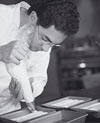 Ramon Morató
Ramon Moratówww.ramonmorato.com
Ramon Morató is the director of Chocolate Academy Chocovic (Barcelona, Spain).
He is also the author of the book ‘Chocolate’ published by grupo vilbo.
